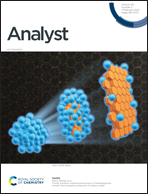Sensitive and non-invasive cholesterol determination in saliva via optimization of enzyme loading and platinum nano-cluster composition†
Abstract
An excessive cholesterol level can lead to cardiovascular diseases, such as stroke, hypertension, and myocardial infarction. A non-invasive, painless method of determining the cholesterol level in blood would improve the user's convenience. To provide rapid and accurate determination of cholesterol, we have developed a simple, disposable, enzyme-based electrochemical biosensor that can detect salivary cholesterol. It is possible to detect low concentrations of cholesterol in saliva using the optimized vertical structure of the platinum nano-cluster (Pt-NC) and the immobilization of a proper volume of an enzyme. The biosensor exhibited a linear range from 2 to 486 μM, the limit of detection was about 2 μM, and the sensitivity of the sensor was calculated to be 132 μA mM−1 cm−2. It also showed good specificity for ascorbic acid, uric acid, dopamine, glucose, and lactate. In a test with an actual sample, the performance of the biosensor was confirmed by measuring total cholesterol in the saliva of a patient with hyperlipidemia. The cholesterol levels measured in the saliva of three patients with hyperlipidemia were 520, 460, and 290 μM. Therefore, the Pt-NC based enzyme sensor is a promising candidate for the detection of cholesterol in human saliva.



 Please wait while we load your content...
Please wait while we load your content...